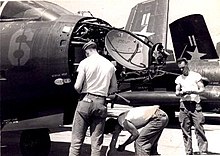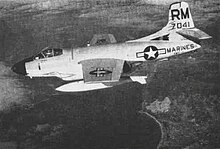Douglas F3D Skyknight
| F3D (F-10) Skyknight | |
|---|---|

| |
| An EF-10B Skyknight of VMCJ-2 Playboys | |
| Role | Fighter aircraft |
| Manufacturer | Douglas Aircraft Company |
| First flight | 23 March 1948 |
| Introduction | 1951 |
| Retired | 1970 |
| Primary users | United States Navy United States Marine Corps |
| Number built | 265 |
The Douglas F3D Skyknight, (later F-10 Skyknight) was a United States twin-engine, midwing jet fighter aircraft manufactured by the Douglas Aircraft Company in El Segundo, California. The F3D was designed as a carrier-based all-weather aircraft. It saw service with the United States Navy and United States Marine Corps. While it never achieved the notoriety of the North American F-86 Sabre it downed several MiG-15s as a night fighter over Korea against no losses of its own. It also served as an electronic warfare platform in the Vietnam conflict. The aircraft is sometimes unofficially called "Skynight", dropping the second "k".
Design and development
The F3D was not intended to be a typical sleek and nimble dogfighter, but it was a night fighter packing a powerful radar system and second crew member. It originated in 1945 with a U.S. Navy requirement for a jet-powered radar-equipped carrier-based night fighter. The Douglas team led by Ed Heinemann designed around the bulky air intercept radar systems of the time, with side-by-side seating for the pilot and radar operator [1]. The result was an airplane with a wide, deep, and roomy fuselage. Instead of ejection seats, an escape tunnel was used, similar to the A-3 Skywarrior[1].

Power was provided by two Westinghouse J34 turbojets mounted in the roots of then-standard straight wings of the early jet era. As a night fighter that was not expected to be as agile as smaller daylight fighters; the expectation was to be a stable platform for its radar system and the four 20 mm cannon mounted in the lower fuselage. The U.S. Navy awarded Douglas a contract for three XF3D-1 prototype aircraft on 3 April 1946. (The losing design from Grumman evolved into the F9F Panther.)[citation needed]
The radar system in the F3D-1 was the Westinghouse AN/APQ-35. The AN/APQ-35 was a combination of three different radars, each performing separate functions: an AN/APS-21 search radar, an AN/APG-26 fire control radar, both located in the nose, and an AN/APS-28 tail warning radar.[2] The complexity of this radar system, which was produced before the advent of semi-conductor electronics, required intensive maintenance to keep it operating fully.[citation needed]
First flight of the XF3D-1 occurred on 23 March 1948 [3]. A production contract for 28 F3D-1 production aircraft soon followed in June 1948. The F3D-1 was followed by the F3D-2, which was first ordered in August 1949. The F3D-2 was intended to have Westinghouse J46 engines in enlarged nacelles to replace the J34—WE-32 engines of the F3D-1. Development problems with the J46 lead to F3D-2 aircraft being fitted with J34-WE-36 engines instead. The F3D-2 also incorporated an improved Westinghouse AN/APQ-36 radar system. A total of 237 F3D-2s were built before production ended on 23 March 1952. A higher performance F3D-3 version with swept wings and J46 engines was planned, but was cancelled when the trouble-plagued J46 engine program was terminated.
Operational history

The few F3D-1 aircraft were used primarily to train F3D crews and did not see combat. F3D-2 aircraft, however, saw extensive service during the Korean War and destroyed more enemy aircraft in Korea than any other Navy or Marine fighter aircraft[4]. Although initially designed to shoot down bombers, they were painted in black and served to escort B-29 Superfortress bombers on night raids. They also flew nighttime intercept and interdiction missions. By the end of the war, while the F-86 Sabre would become famous for victories over MiG Alley, Skyknights had shot down six enemy aircraft (one Polikarpov Po-2 and five Mikoyan-Gurevich MiG-15) without a loss.[5] The first air-to-air victory occurred on 3 November 1952 in a United States Marine Corps F3D-2 piloted by Major William T. Stratton, Jr. and radar operator Master Sergeant Hans C. Hoglind of VMF(N)-513.[5] While the Skyknight lacked the graceful swept wings and high subsonic performance of the MiG-15, its onboard radar enabled it to find and kill other fighters, while the MiG-15 could only be guided by ground-based radar to the general vicinity of large B-29 formations.
In the years after the Korean War, the F3D was gradually replaced by more powerful aircraft with better radar systems. The F3D's career was not over though; its stability and spacious fuselage made it easily adaptable to other roles. The F3D (under the designations F3D-1M and F3D-2M) was used to support development of a number of air-to-air missile systems during the 1950s, including the Sparrow I, II, and III and Meteor missiles[citation needed].
The F3D-2M was the first operational Navy jet aircraft to be fitted with an air-to-air missile, the Sparrow I, a missile that used beam riding guidance for the aircrew to control the flight of the missile. Only 38 aircraft (12 F3D-1Ms[6], and 16 F3D-2Ms[7]) were made able to use the missiles.
In the late 1950s, a number of the Marine F3D-2 aircraft were re-configured as electronic warfare aircraft and were designated F3D-2Q (later EF-10B). Also, a few aircraft were converted for use as trainers and were designated F3D-2T.

Skyknights continued service through the 1960s in gull white color scheme, when their contemporaries had long since been retired. In 1962, when the U.S. Navy and U.S. Air Force unified their designation systems, the F3D-1 was redesignated F-10A and the F3D-2 was re-designated F-10B. The Skyknight was the only Korean war fighter that also flew in Vietnam (as also did the A-1 Skyraider attack plane). EF-10Bs served in the electronic countermeasures role during the Vietnam War until 1969. The U.S. Marine Corps retired its last EF-10Bs in 1970. Some aircraft continued flying as testbeds for Raytheon until the 1980s.[8]
When the U.S. Navy issued a requirement for a fleet defense missile fighter in 1959, Douglas responded with the F6D Missileer, essentially an updated and enlarged F3D that would carry the AAM-N-10 Eagle long-range missile with the most important characteristics being able to carry a large load of fuel, long time-on-station, crew of two, and sophisticated electronics rather than speed or maneuverability. This concept which kept the straight wings in an age of supersonic jets was soon cancelled because it would not be able to defend itself against more nimble fighters.[9][10] Its weapon system would be adapted for the supersonic swing-wing General Dynamics/Grumman F-111B which also specified side-by-side seating, but would also prove vulnerable to MiGs. The AWG-9/Phoenix and TF30 turbofan engine (with afterburner) would eventually reach service on the F-14 Tomcat which could swing its wing straight forward for loiter.
The unusual portly profile earned it the nickname "Willie the Whale".[11] It is less clear how it also came to be known "drut."[12][13][14][15] It should be noted, however, that "Drut" is "Turd" spelled backward.
Variants
- XF3D-1
- Prototype aircraft, three built.
- F3D-1 Skyknight
- Two-seat all-weather day or night-fighter aircraft, powered by two 3,000 lbf (1,400 kgf) Westinghouse J34-WE-32 turbojet engines, 28 built.
- F3D-1M Skyknight
- 12 F3D-1s were converted into missile-armed test aircraft. Used in the development of the AIM-7 Sparrow air-to-air missile.
- F3D-2 Skyknight
- Improved version, powered by two 4,600 lbf (2,100 kgf) Westinghouse J34-WE-36 or J34-WE-36A turbojet engines, equipped with an autopilot and a Westinghouse AN/APQ-36 radar, 237 built.
- F3D-2B Skyknight
- One F3D-1 Skynight was used for special armament test in 1952.
- F3D-2M Skyknight
- 16 F3D-2s were converted into missile armed aircraft. The F3D-2Ms were armed with AIM-7 Sparrow air-to-air missiles.
- F3D-3Q Skyknight
- 35 F3D-2s were converted into electronic warfare aircraft.
- F3D-2T Skyknight
- Five F3D-2s were converted into night fighter training aircraft.
- F3D-2T2
- 55 F3D-2s were used as radar-operator trainers and electronic warfare aircraft.
- F3D-3 Skyknight
- Unbuilt project, intended to be an advanced version fitted with swept wings.
- F-10A Skyknight
- 1962 re-designation of the F3D-1.
- F-10B Skyknight
- 1962 re-designation of the F3D-2.
- EF-10B Skyknight
- 1962 re-designation of the F3D-2Q.
- MF-10A Skyknight
- 1962 re-designation of the F3D-1M.
- MF-10B Skyknight
- 1962 re-designation of the F3D-2M.
- TF-10B Skyknight
- 1962 re-designation of the F3D-2T2.
Operators
Aircraft on display
- F3D-2, BuNo 124598, National Museum of Naval Aviation, NAS Pensacola, Florida
- BuNo 125807, Combat Air Museum, Topeka, Kansas
- F3D-2 USS Intrepid Museum, New York City. (Operated by Raytheon in Massachusetts as an electronics test plane until it was donated to the museum in 1987. It is painted in the colors of Marine night fighter squadron VMFN-513 as flown during the Korean War.)
- F3D-2, BuNo 124629, Pima Air and Space Museum, adjacent to Davis-Monthan AFB in Tucson, Arizona. This aircraft is painted in the colors of Marine Night Fighter Training Squadron 20 (VMFT(N)-20).[16]
Specifications (F3D-2)

Data from Standard Aircraft Characteristics F3D-2 "Skyknight" [17]
General characteristics
- Crew: 2
Performance
- Thrust/weight: 0.32
Armament
- Guns: 4 × 20 mm Hispano-Suiza M2 cannon, 200 rpg
- Missiles: 4× Sparrow I air-to-air missiles (F3D-2M)
- Bombs: 2 × 2,000 lb (900 kg) bombs
See also
Related development
Aircraft of comparable role, configuration, and era
Related lists
- List of fighter aircraft
- List of military aircraft of the United States
- List of military aircraft of the United States (naval)
References
- Notes
- ^ a b Donald 1997, p. 365.
- ^ Badrocke 1993, pp. 41, 44–45.
- ^ The Illustrated Encyclopedia of Aircraft 1985, p. 1559.
- ^ Douglas F3D-2 "Sky Knight." Flying Leatherneck Historical Foundation and Aviation Museum. Retrieved: 16 December 2007.
- ^ a b Grossnick, Roy A. and William J. Armstrong. United States Naval Aviation, 1910–1995. Annapolis, Maryland: Naval Historical Center, 1997. ISBN 0-16049-124-X.
- ^ Swanborough and Bowers 1976, p. 183.
- ^ Swanborough and Bowers 1976, p. 182.
- ^ "Douglas F3D-2 Skyknight." Intrepid Sea, Air & Space Museum. Retrieved: 6 March 2008.
- ^ Badrocke 1993, p. 47.
- ^ Francillon 1979, p. 717.
- ^ "Douglas Sknight." Boeing history. Retrieved: 23 August 2010.
- ^ Goebel, Greg. "Douglas F3D Skyknight." vectorsite.net. Retrieved: 25 2010.
- ^ Burchardt, Bob. "The Drut was underpowered." aero-web.org. Retrieved: 25 July 2010.
- ^ Lacey, John. "Nicknamed the ‘Drut’ during its service in Vietnam." fortunecity.com. Retrieved: 25 July 2010.
- ^ "Naval Aviation Humor." bluejacket.com. Retrieved: 25 July 2010.
- ^ "Douglas TF-10B Skyknight." pimaair.org. Retrieved: 23 August 2010.
- ^ "Standard Aircraft Characteristics F3D-2 'Skyknight'." Naval Historical Centre. Retrieved: 23 June 2007.
- Bibliography
- Andrade, John M. U.S. Military Aircraft Designations and Serials since 1909. Earl Shilton, Leicester, UK: Midland Counties Publications, 1979, ISBN 0-904597-22-9.
- Badrocke, Mike. "Electronic Warrior". Air Enthusiast, Fifty-one, August to October 1993, pp. 41–48. Stamford, UK: Key Publishing. ISSN 0143-5450.
- Donald, David, ed. The Encyclopedia of World Aircraft. London: Aerospace Publishing, 1997. ISBN 1-85605-375-X.
- Francillon, René. McDonnell Douglas Aircraft Since 1920. London: Putnam, 1979. ISBN 0-370-00050-1.
- Heinemann, Edward H. and Rosario Rausa. Ed Heinemann: Combat Aircraft Designer. Annapolis, Maryland: Naval Institute Press, 1980. ISBN 0-87021-797-6.
- The Illustrated Encyclopedia of Aircraft (Part Work 1982-1985). London: Orbis Publishing, 1985.
- Jones, Lloyd. U.S. Fighters: Army-Air Force 1925 to 1980s. Fallbrook, California: Aero Publishers, 1975. ISBN 0-8168-9200-8.
- Jones, Lloyd. U.S. Naval Fighters: 1922 to 1980s. Fallbrook, California: Aero Publishers, 1977. ISBN 0-8168-9254-7.
- Swanborough, Gordon and Peter M. Bowers. United States Navy Aircraft since 1911. London: Putnam, Second edition, 1976. ISBN 0-370-10054-9.
